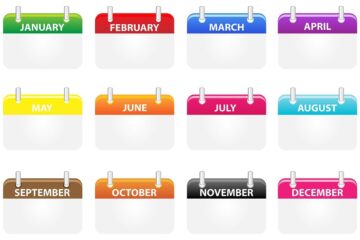(Reminder: Posts in the “At A Glance” category are designed to help find information quickly … certain tools, techniques, concepts which may be imbedded elsewhere on the blog, along with year-end blog summaries.)
This “At A Glance” post is meant as a quick reference for using a tool I detailed more fully in last year’s series of posts … “Talk With The Dead” … based around the research of scientist Julie Beischel, PhD. It was featured in Part 4C of the series.
“Using A Pendulum” at a Glance
The pendulum is a tool that can be used to communicate with those in Spirit … departed loved ones, spirit guides, angels, and so forth. Further context can be found in the post mentioned above, these are simply instructions for how to use one. So let’s get started …
Getting Started
Take an object which has some weight to it and comes to a fixed point … a pendant, for example … and attach it to a chain, or anything that can move freely.
Set the Stage
Take a minute or two to set the stage …
- Become quiet and calm your energy … perhaps breathe deeply a few times.
- Set an intention for who you want to communicate with … a specific loved one, a spirit guide, or simply higher wisdom to provide guidance, always in your best interest only.
- Open your heart to receive what comes.
Calibrate the Pendulum
The most basic use of the pendulum is to simply ask yes/no questions. After asking a question, the pendulum will move, and the direction of its movement will signal the answer. We start by establishing which movement will correspond to each answer …
Step 1 – Hold Still
Hold the end of the chain lightly in your fingers so it’s hanging straight down and your fingers or hands won’t influence its movement. Allow the pendant to come to a rest.
Step 2 – Show ‘Yes’ Response
Either out loud or to yourself, ask to be shown the movement that will correspond to a “yes” answer.
The pendulum will start to move … typically either side-to-side or front-to-back. Notice the movement. When you see this movement again, it will mean you’re receiving a positive response to whatever you’re asking about.
Step 3 – Reset
When that’s firmly established, ask the pendulum to stop … please. (Remember you’re talking to someone, they just happen to be on the Other Side.)
Step 4 – Show ‘No’ Response
Once it’s stopped, ask to be shown a “no.” Usually, this will be the other direction than what you were just shown. Again, notice the movement.
Any other movement … for example, going around in a circle, diagonally, or sometimes no movement at all … is either “maybe,” “doesn’t matter,” or “not gonna tell ya.” In other words, you’re really not meant to know the answer at this point … or perhaps ever.
Step 5 – Reset and Start
Once more, ask the pendulum to (please) stop and you’re ready to start asking questions!
What kind of questions?
You can ask just about anything, but the key is to word each question clearly and in such a way that it can be answered with a yes or a no.
It can be something simple, like whether it’s a good idea to eat a particular food, or to send that controversial text. Or it can be about something difficult, like an important or challenging decision you’re wrestling with.
However … in my experience, I’ve found the questions must be relevant to me, not to someone else. And they have to be important for me to know right now, whether it’s something big or small.
If not, the answers either don’t come, or if they do, they can’t be trusted. I can’t say whether this is the case for everyone, but it seems to make sense.
Getting more sophisticated
To get more than yes/no responses, print out an alphabet chart, like this one or any other you find online that draws your attention.

Try holding the pendulum over the centre of the chart and watch it swing to a letter. If you can discern which letter it’s pointing to, you’ll find it will spell out actual words and sentences … much more informative than a simple yes or no!
I’ve never been able to master this, but at least one good friend of mine has and I’ve been the beneficiary of her talent.
So, whether your skills extend to reading an alphabet chart or, like me, are rooted in yes/no questions only, this is a tool that may open a line of communication with someone you’re wanting to reach out to on the Other Side.
If it feels right, give it a try. And remember … as with guidance from any source, the decision about whether to follow it is ALWAYS up to you.
(For examples of a pendulum being used to connect with departed loved ones, check out Meet Up At Your Funeral…? (Part 2) or The Swing of the Pendulum series.)
To sign up for notifications of future posts, click here.



0 Comments